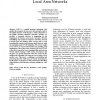Free Online Productivity Tools
i2Speak
i2Symbol
i2OCR
iTex2Img
iWeb2Print
iWeb2Shot
i2Type
iPdf2Split
iPdf2Merge
i2Bopomofo
i2Arabic
i2Style
i2Image
i2PDF
iLatex2Rtf
Sci2ools
JCM
2007
2007
Experimental Analysis of VoIP over Wireless Local Area Networks
—VoIP is a rapidly growing technology that enables the transport of voice over data networks such as the public Internet. VoIP became a viable alternative to the public switched telephone networks (PSTNs). In parallel, a dramatic increase is happening in the deployment of Wireless Local Areas Networks (WLAN) in buildings and corporate campuses. Nowadays, WLAN is mostly used for ordinary data services such as web browsing, file transfer and electronic mail. However, with the emerging usage of VoIP telephony, WLAN are sought to be used as an access infrastructure for enabling such applications. One of the issues of using VoIP over WLAN is the effects caused by users roaming within and between WLAN subnets during a VoIP session. The latency and the jitter are greatly impacted when the control of the mobile node is handed over from one access point (AP) to another one. This poses a challenge to providing and preserving QoS for VoIP users in WLAN environments. In this paper, we propose to...
| Added | 15 Dec 2010 |
| Updated | 15 Dec 2010 |
| Type | Journal |
| Year | 2007 |
| Where | JCM |
| Authors | Abderrahmane Lakas, Mohammed Boulmalf |
Comments (0)

